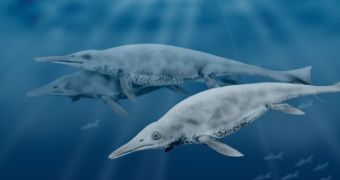The Luoping fossil site in the Yunnan Province in south-west China, has provided valuable fossils that shed light on the way that life on Earth has recovered from the greatest mass extinction in our planet’s history.
The work is led by scientists from the Chengdu Geological Center in China and was presented in a paper so-authored by Professor Mike Benton, in the School of Earth Sciences, Bristol University.
250 million years ago, at the end of the Permian Period, because of massive volcano eruptions and a devastating global warming, life on Earth got close to being wiped out.
Only one in ten species were lucky enough to survive and they became the basis for the recovery of life during the following period – the Triassic.
This new fossil site in China contains information on that recovery period, and the researchers found that it took nearly 10 million years before a fully-functioning ecosystem could develop.
Professor Benton explained that “the Luoping site dates from the Middle Triassic and contains one of the most diverse marine fossil records in the world.
“It has yielded 20,000 fossils of fishes, reptiles, shellfish, shrimps and other seabed creatures.
“We can tell that we’re looking at a fully recovered ecosystem because of the diversity of predators, most notably fish and reptiles.
“It’s a much greater diversity than what we see in the Early Triassic – and it’s close to pre-extinction levels.”
Another argument sustaining the full-recovery theory is the diversity and the complexity of the food web during the later Triassic – with specific species of marine faunas (crustaceans, fishes and bivalves), different from previous ones.
And let's not forget the beginning of top predators that fed on fishes and small predatory reptiles: the long-snouted bony fish Saurichthys, the ichthyosaur Mixosaurus, the sauropterygian Nothosaurus and the prolacertiform Dinocephalosaurus.
“It has taken us three years to excavate the site, and we moved tonnes of rock,” said Professor Shixue Hu of the Chengdu Group.
“Now, with thousands of amazing fossils, we have plenty of work for the next ten years!”
Professor Benton added that “the fossils at Luoping have told us a lot about the recovery and development of marine ecosystems after the end-Permian mass extinction.
“There’s still more to be discovered there, and we hope to get an even better picture of how life reasserted itself after the most catastrophic global event in the history of our planet.”
This paper was published this week in the Proceedings of the Royal Society B.

 14 DAY TRIAL //
14 DAY TRIAL //